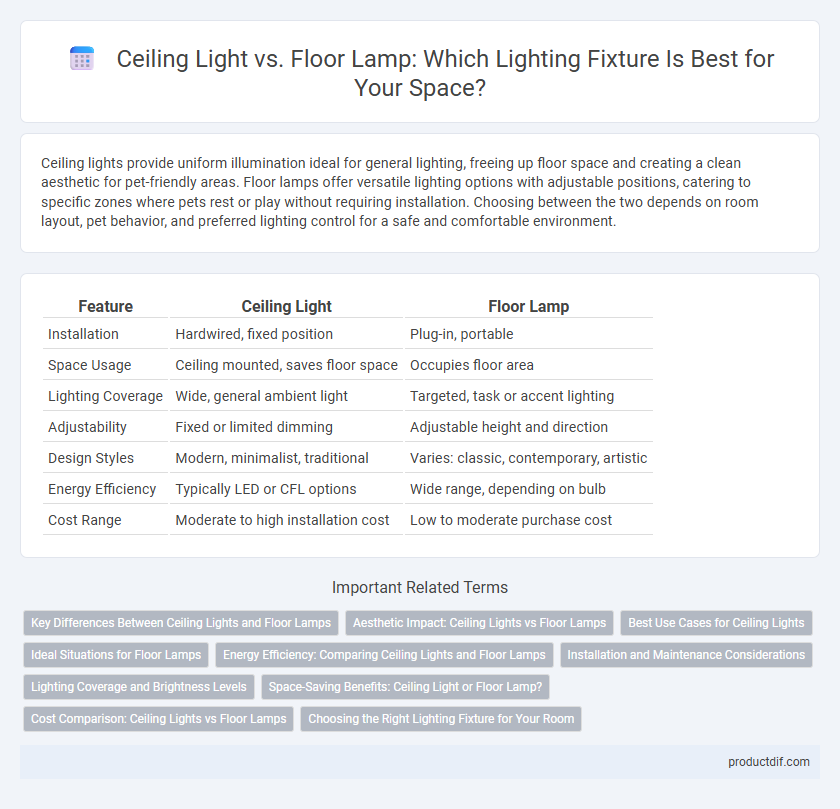Ceiling lights provide uniform illumination ideal for general lighting, freeing up floor space and creating a clean aesthetic for pet-friendly areas. Floor lamps offer versatile lighting options with adjustable positions, catering to specific zones where pets rest or play without requiring installation. Choosing between the two depends on room layout, pet behavior, and preferred lighting control for a safe and comfortable environment.
Table of Comparison
| Feature | Ceiling Light | Floor Lamp |
|---|---|---|
| Installation | Hardwired, fixed position | Plug-in, portable |
| Space Usage | Ceiling mounted, saves floor space | Occupies floor area |
| Lighting Coverage | Wide, general ambient light | Targeted, task or accent lighting |
| Adjustability | Fixed or limited dimming | Adjustable height and direction |
| Design Styles | Modern, minimalist, traditional | Varies: classic, contemporary, artistic |
| Energy Efficiency | Typically LED or CFL options | Wide range, depending on bulb |
| Cost Range | Moderate to high installation cost | Low to moderate purchase cost |
Key Differences Between Ceiling Lights and Floor Lamps
Ceiling lights provide overhead illumination that evenly distributes light across a room, making them ideal for general lighting and maximizing space. Floor lamps offer versatile, portable lighting solutions that can be positioned to enhance specific areas or create ambient moods, often featuring adjustable brightness and styles. Key differences include installation method, lighting coverage, and flexibility, with ceiling lights requiring fixed placement and floor lamps delivering mobility and targeted illumination.
Aesthetic Impact: Ceiling Lights vs Floor Lamps
Ceiling lights create a streamlined, modern ambiance by evenly illuminating the space without occupying floor area, enhancing rooms with clean lines and minimal visual clutter. Floor lamps act as flexible design elements, offering both functional lighting and decorative appeal, often serving as statement pieces that add height and texture to a room's aesthetic. Choosing between ceiling lights and floor lamps depends on desired visual impact, spatial dynamics, and the balance between integrated lighting and sculptural decor.
Best Use Cases for Ceiling Lights
Ceiling lights provide consistent, evenly distributed illumination, making them ideal for general lighting in kitchens, living rooms, and offices where broad visibility is crucial. They optimize space by being mounted overhead, which is beneficial in rooms with limited floor area or for creating a clean, uncluttered look. Ceiling lights are also well-suited for high-traffic areas and places requiring moisture resistance, such as bathrooms and hallways.
Ideal Situations for Floor Lamps
Floor lamps are ideal for providing adjustable and focused lighting in living rooms, reading nooks, or bedrooms where overhead lighting may be insufficient or harsh. They offer flexibility in placement and can easily be moved to enhance ambiance or highlight specific areas without requiring installation. Floor lamps complement ceiling lights by adding layers of light and creating cozy, inviting spaces through targeted illumination.
Energy Efficiency: Comparing Ceiling Lights and Floor Lamps
Ceiling lights often provide more energy-efficient illumination due to their ability to evenly distribute light across a room, reducing the need for multiple fixtures. LED ceiling lights consume significantly less power compared to traditional bulbs used in some floor lamps, leading to lower electricity bills and decreased environmental impact. Floor lamps, while flexible in placement, typically illuminate smaller areas and may require higher wattage bulbs to achieve similar brightness levels as ceiling lights.
Installation and Maintenance Considerations
Ceiling lights require professional installation involving wiring and secure mounting, which may increase initial setup time and cost. Floor lamps offer plug-and-play convenience with minimal assembly, making them easy to reposition and maintain without electrical expertise. Regular dusting and bulb replacement apply to both, but ceiling fixtures can be harder to access, impacting maintenance frequency and effort.
Lighting Coverage and Brightness Levels
Ceiling lights provide broad, even lighting coverage suitable for general illumination across an entire room, making them ideal for task-oriented spaces. Floor lamps offer adjustable brightness levels and directional lighting, allowing for focused illumination and ambiance control in specific areas. Combining both fixtures can optimize lighting coverage and enhance overall brightness versatility in any living space.
Space-Saving Benefits: Ceiling Light or Floor Lamp?
Ceiling lights offer significant space-saving benefits by being mounted directly onto the ceiling, freeing up valuable floor area for furniture or movement. Floor lamps, while versatile and portable, occupy floor space and can clutter small rooms, limiting their functionality. Choosing a ceiling light enhances room openness and maximizes usable space, making it ideal for compact living environments.
Cost Comparison: Ceiling Lights vs Floor Lamps
Ceiling lights generally have a higher upfront installation cost, often ranging from $100 to $500 depending on the complexity and fixture style, while floor lamps typically cost between $50 and $300 with no installation required. Maintenance expenses for ceiling lights can include bulb replacements and occasional professional servicing, whereas floor lamps usually only require bulb changes. Long-term energy efficiency varies by bulb type, but LED ceiling lights tend to lower electricity bills compared to traditional floor lamps using incandescent bulbs.
Choosing the Right Lighting Fixture for Your Room
Ceiling lights provide broad, evenly distributed illumination ideal for general lighting in living rooms, kitchens, or bedrooms, while floor lamps offer flexible, targeted lighting perfect for reading nooks or accent areas. Consider room size, lighting needs, and existing decor when selecting between these fixtures, as ceiling lights optimize overhead space without clutter and floor lamps add warmth and mobility. Energy efficiency, bulb type, and installation complexity also influence the best choice for creating a balanced and functional lighting scheme.
Ceiling Light vs Floor Lamp Infographic

 productdif.com
productdif.com